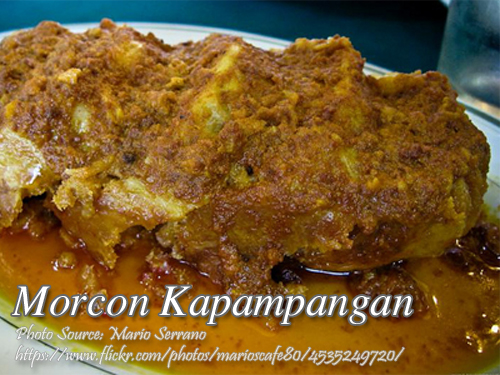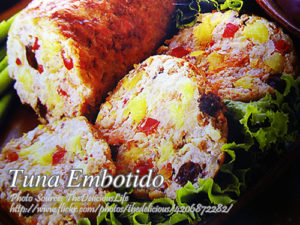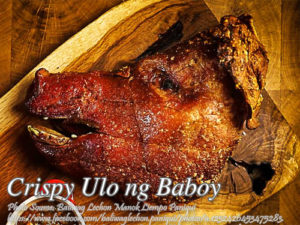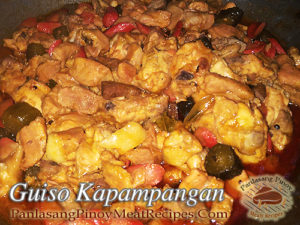Morcon Kapampangan or Murcon is different from the morcon we commonly know. The usual morcon if made from wide and thin slice of marinated beef filled with sliced boiled eggs, sausages or hotdog and rolled up to form a cylinder, tied up with thick thread and then simmered until cooked.
The Kapampangan version of morcon is made from ground pork and beef, chorizo, onions, raisins, eggs, grated cheese and wrapped in pig’s caul fat. it is then steamed or simmered until cooked. This morcon look very similar to embotido and after it is sliced, the drippings from the steamer will be poured with the oil. The morcon is best when submerged on it’s own fat.
Morcon Kapampangan: A Family Tradition with a Twist
I remember the very first time I tasted Morcon Kapampangan. It wasn’t on the usual holiday table, but instead, it was a special recipe of my Tita Lilia that she prepared for our family gathering during a rainy Sunday. For years, she learned her version of morcon from Pampanga, where she spent most of her upbringing. She learned this from her mother, my Lola Remy, who has been doing it for decades and following a family recipe passed down generations. Unlike the often-popular version of morcon that you might be familiar with – it’s made up of rolled beef, sausage, and boiled eggs- the Kapampangan way is different yet comfortingly unique. Each bite is like a warm hug, rich in tradition and taste.
The Kapampangan Difference
This is what makes Morcon Kapampangan, or what we sometimes call murcon in Pampanga, unique with the addition of ground meat and caul fat making it a singularly textured and rich dish. It is more akin to embutido but with deeper, richer profile. The mix of ground pork and beef, flavored with chorizo, raisins, and cheese, then wrapped in delicate caul fat that renders into a flavorful and crispy outer layer, makes for quite an excellent dish.
What sets it apart for me is that my Tita always insisted that we use duck eggs, not chicken eggs; she says that makes the dish feel luxurious because of the richer yolks of the duck eggs. It’s these little nuances that make each version so uniquely personal.
As a matter of fact, the first time I helped her prepare it, she said that it has to be steamed low and slow. It may take hours, but the end result is always worth it: tender, juicy, and bursting with the flavors of home.
A Dish with Tradition
With Pampanga’s reputation as the Culinary Capital of the Philippines, it comes as no surprise that it has its own version of morcon. Kapampangans are known for being bold and even indulgent with flavors. This recipe fits right in with its caul fat wrapping. So all the drippings throughout the cooking will get most of this recipe. Once the morcon is finally sliced, the fat is simmered and poured over the top for its richer depth in every bite.
My Lola Remy always looked back fondly on how murcon was always a fixture at all those grand, big family gatherings, but especially during fiesta. It is making the murcon that the whole family would gather together: chopping up the ingredients, rolling the meat, and tending to the steamer for hours. This was about feeding the family; how everyone came together in the kitchen, sitting down to share stories, learn secrets from each other in the preparation of it.
How to Enjoy Morcon Kapampangan
My Tita would always say that the best part of making this dish was always the first slice, when the savory aroma of the drippings hits the air. When I helped her slice through the cooked roll, the ground meat, chorizo, and raisins would be perfectly layered, just the right amount of oil glistening on top. Always, it was served with hot steamed rice, but to her liking is added with garlic-fried rice on the side for extra flavors.
Another piece of advice my Kuya Jun told me is to start with slicing the morcon just slightly cooled down, so that will hold the roll intact and won’t crumble upon slicing. Then, once you are ready to present it, remember to pour the drippings over the top and garnish it with crunchy-fried garlic. A simple step but sensational enough to turn the dish to something really exquisite as a crunchy finish, garlicky aftertaste of the soft flavor inside the meat.
A Taste of Home in the Past
With this version of morcon, memories flood back on cozy family gatherings in Pampanga, when the kitchen is filled with chatter from cousins, aunts, and uncles. Whenever we cooked together, bonding happened, and, of course, food was at the center of our celebrations. Lola would sit in her chair and watch over us while smiling as we tried to roll and wrap just right.
For a lot of Filipinos, food is not just for sustenance. It’s that special connection with their roots, with family, and memories. Morcon Kapampangan holds a very special place in my heart. It says something to me with every bite: those Saturdays which evoke a young me-all day spent in the kitchen, learning the best home cooks in the family for hours on end. It is more than just food; it’s more than just a dish; it’s more about celebrating where we came from and the love that goes to every meal, really.
A Recipe to Share
No need to be scared if you are a first-timer at making Morcon Kapampangan-it may look kind of intimidating, but with a little patience, you will be rewarded by this rich and savory dish. The secret lies in the slow steaming, wherein the flavors get combined and the caul fat becomes crispy with perfection.
I should say that it is best to prepare this for lunch or dinner early in the morning since you would want to stir-fry this mixture low and slow so that meat does not become hard and dry. The generous mix of cheese, chorizo, and raisin provides a delightful balance between sweet and savory.
It has now become a tradition for my family to cook Morcon Kapampangan when we are having a special celebration. I have passed down the recipe to my children, as my Tita and Lola had done for me, so this wonderful dish will keep on giving warmth and happiness to our gathering for years.
Final Thoughts
Morcon Kapampangan is not only a dish but also a piece of heritage in our culinary side. This epitomizes Kapampangan cuisine, replete with rich flavors and meticulous preparation. It can be an instance of first making this recipe or one already enjoyed at home; there is a deep comfort in having a meal steeped in tradition. After all, in Filipino culture, food is more than just food—it’s a way to bring people together, celebrate, and pay homage to our roots.
How to Cook Morcon Kapampangan
Ingredients
- 1 kilo ground pork
- 1/2 kilo ground beef
- 10 pcs duck egg yolks
- 1/2 cup minced onions
- 1/2 cup raisins
- 1 cup finely grated Queso de Bola or cheddar cheese
- 1/2 cup diced fresh tomatoes
- 1/2 cup fried garlic
- 2 pcs Chorizo de Bilbao sliced lengthwise
- 100 grams annatto seeds atsuete, pour 1/8 cup hot water and strain
- pig's caul fat pig intestine membrane for wrapping
- salt and pepper to taste
Instructions
How to cook Morcon Kapampangan :
- In a bowl, mix together ground pork, ground beef, duck egg yolks, onions, raisins, grated cheese, tomatoes and garlic. Set aside.
- Cut a portion of the pig's caul fat and place a handful of the morcon mixture on it.
- Spread out the mixture and top with 2 to 3 slices of the chorizo.
- Roll the morcon like a cylinder and do the same with the rest of the mixture.
- Arrange the morcon on a deep plate with the annatto water and put in the steamer filled to 3/4 and steam for 4 to 5 hours on a very low fire.
- Let cool. When cooled, remove the morcon from the steamer and slice then place on a platter.
- Simmer the morcon drippings until it solidifies.
- Pour oil and dripping over morcon slices. Garnish with fried garlic on top.
- Serve immediately with steamed rice.
Notes
Cooking Tips:
Use Fresh Caul Fat for the Best Results
Also, your caul fat should be fresh. Then you are going to attain the right texture and flavor when done. It helps to keep the juiciness of meat intact and crisps beautifully during steaming. Always rinse then pat dry the fat, before wrapping with the morcon mixture, so that it would not tear.Morcon Rest Before Slicing
Let it cool down for a while after steaming, then slice the morcon. The resting time allows the meat to set, which means cleaner slices and firmer texture. Cutting it too soon will cause the roll to crumble, making it almost impossible to serve neatly.Don’t Skip the Drippings
The drippings collected in the steamer are packed with flavor, which should be saved. Simmering the drippings until they thicken makes the dish even richer so that every slice of morcon is an even greater treat. Pour the drippings over the slices to give a glossy, rich finish to the presentation.





